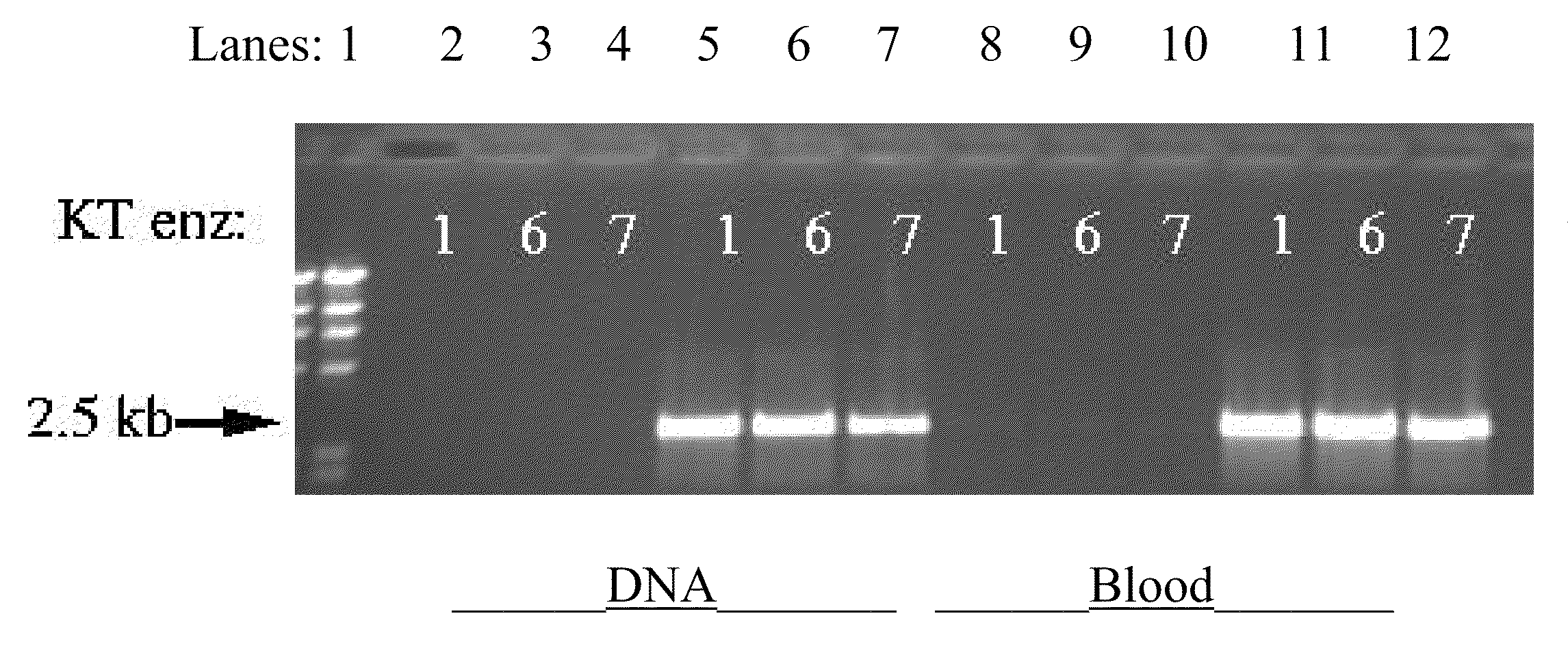Use of whole blood in PCR reactions
a technology of pcr and whole blood, which is applied in the direction of enzymology, peptides, transferases, etc., can solve the problems of affecting the sensitivity of the blood sample, causing false negative reactions or low sensitivity, and consuming time and labor
- Summary
- Abstract
- Description
- Claims
- Application Information
AI Technical Summary
Benefits of technology
Problems solved by technology
Method used
Image
Examples
example 1
Screening of Mutagenized Klentaq Clones for Blood-Resistant Mutant Enzyme Activity
[0120]In order to functionally characterize new mutants, it is desirable to produce highly-purified enzyme from expression systems. The procedure, which included PEI treatment, BioRex-70 chromatography, and Heparin-Agarose chromatography, yielded DNA-free and nuclease-free Klentaq enzyme purified to homogeneity, as judged by a single band in Coomassie stained protein gel (23). The same purification procedure also worked very well for purification of cold sensitive Klentaq mutants (23). This procedure was readily adaptable to accommodate purification of mutant polymerases that display unusual features such as changed affinity and elution profile on a particular chromatography resin. The efficiency of each step in the purification scheme was monitored easily by a standard DNA incorporation assay.
[0121]The amplification activity of the obtained mutant enzymes were extensively evaluated in PCR amplificatio...
example 2
Full-Length Taq DNA Polymerase Mutants Display Blood-Resistant Activity
[0125]Importantly, the amino acid changes responsible for the blood-resistant phenotype of the Klentaq, were also sufficient to render the full-length Taq blood-resistant when these amino acid changes were incorporated into the full-length gene. For example, the amino acid changes of KT-10 and KT-12 mutants were incorporated into the full-length Taq gene to generate the analogous Taq-mutants FL-10 and FL-12. As shown in FIG. 3A (for FL-10) and FIG. 3B (for FL-12), both full-length Taq mutants exhibited very high resistance to blood inhibition, and successfully amplified the endogenous human Dystrophin and CCR5 genes in homogeneous PCR solutions containing 20% blood. The observed high blood resistance of these mutants reflects dramatic change in the property of the Taq enzyme, considering the fact that the wild-type Taq is typically inactivated in homogeneous PCR assay solutions containing as little as 0.1-0.5% wh...
example 3
Mutagenized Klentaq Mutants with a Faster DNA Elongation Rate
[0126]The screening factor here is to simply shorten the DNA extension step of the PCR cycle beyond the point where the wild-type or prior art enzyme stops working. In the case when wild-type Klentaq amplified its own gene, the amplification efficiency was significantly lower at 60 seconds extension step (FIG. 4A, lane 1 at 1 min). Additional tests with discrete extension times showed that the Klentaq polymerase did not display amplification activity in PCR assays performed under conditions that employ an extension time of about 50 sec or less (e.g., see FIG. 4A, lane 1 at 30 sec and 20 sec). On the other hand, mutant Klentaq clone KT-7 displayed amplification activity with the same target in PCR assays under conditions having an extension step of as little as about 12 sec. (FIG. 4B, lower panel). For the evaluation of fast-elongating mutants, extension times in the PCR cycle not exceeding 20 sec per 2 kb amplicon were use...
PUM
| Property | Measurement | Unit |
|---|---|---|
| Fraction | aaaaa | aaaaa |
| Fraction | aaaaa | aaaaa |
| Fraction | aaaaa | aaaaa |
Abstract
Description
Claims
Application Information
 Login to View More
Login to View More - R&D
- Intellectual Property
- Life Sciences
- Materials
- Tech Scout
- Unparalleled Data Quality
- Higher Quality Content
- 60% Fewer Hallucinations
Browse by: Latest US Patents, China's latest patents, Technical Efficacy Thesaurus, Application Domain, Technology Topic, Popular Technical Reports.
© 2025 PatSnap. All rights reserved.Legal|Privacy policy|Modern Slavery Act Transparency Statement|Sitemap|About US| Contact US: help@patsnap.com



